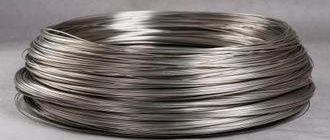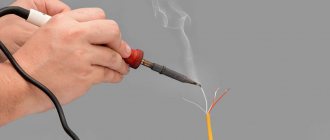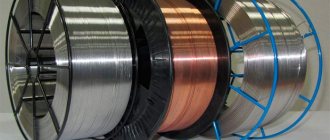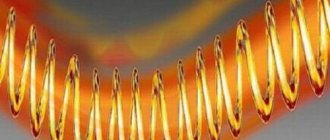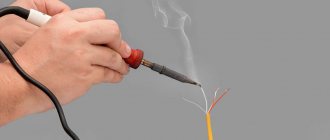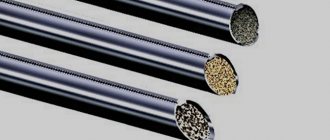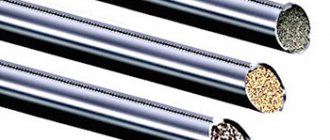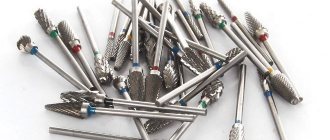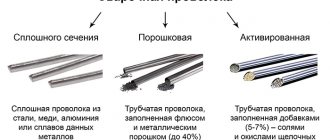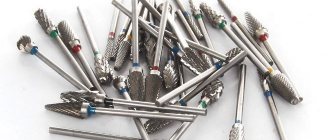- By purpose
- By structure
- By surface type
- According to welded metals and composition
- Steel welding wire
- Copper-plated welding wire
- Stainless steel welding wire
- Aluminum wire
- Cored wire
- What to choose – welding electrodes or wire?
Welding wire is one of the main welding materials used in high-tech semi-automatic arc welding in MIG/MAG shielding gases. It is also used as a filler rod using a non-consumable TIG electrode, as well as a base material for the manufacture of coated stick electrodes for manual MMA arc welding.
When working with an automatic welding machine, all welding processes: wire feeding, ignition, maintaining the welding mode, its completion are mechanized. When using a semi-automatic machine, only the supply of filler material is mechanized; the welding torch is moved manually.
Advantages of stainless steel
This type of product is intended for joining steels containing nickel and chromium in a gas-protective environment . The advantages of such additives include:
- excellent quality of welding seam;
- absence of cracks and other defects on its surface;
- high degree of corrosion resistance;
- slight splashing of the metal alloy during operation;
- stable arc.
Stainless steel wire also has a long service life. It is made from high-alloy steels with the addition of nickel, chromium and other elements that prevent the development of corrosion.
These consumables can be of two types:
- powder;
- solid.
The latter is used for submerged arc welding or shielding gas welding. The main task of such products is to prevent air from entering the junction of elements, so that no gases can oxidize the stainless steel.
Flux-cored wires are thin tubes with flux and elements that form gases. Due to the fact that this material makes it possible not to use a protective mixture of gases during operation, it is often called self-protective.
Steel
Welding wire is made by cold drawing steel blanks with a low carbon content, a moderate amount of alloying additives and from high-alloy raw materials.
GOST 2246 70 standardizes the characteristics of welding wire made of all types of steel. The standard stipulates the division of products into two groups. The first is wire for surfacing, the second is for making electrodes. Belonging to the second group is marked with the letter E.
A product with a low carbon content and a moderate amount of alloying additives is available with or without copper plating. Copper-plated welding products are marked with the letter O.
The specific concentration of copper in the coating is specified in the technical specifications (TS) approved for each type of wire product. The standard specifies the thickness (diameter) of all products with maximum permissible deviations.
The marking includes a set of letter designations and numbers that you need to navigate to correctly select wire products.
The designation St informs that this type of welding product is intended for welding. The next number displays the mass fraction of carbon expressed as a percentage. The following are letters indicating the presence of additives.
Nitrogen is contained only in wire products with a high degree of alloying of steel raw materials. In such cases, indicate the letter A. The presence of niobium is indicated by the letter B, tungsten - B, manganese - G, copper - D, molybdenum - M, nickel - N, silicon - C.
The presence of titanium is indicated by the letter T, vanadium - F, chromium - X, zirconium - C, aluminum - Y. You should pay attention to the information presented also because the letter does not always correspond to the name of the chemical element.
Each letter symbol is followed by a number indicating the average mass fraction of the element in the steel alloy. If the number is not indicated, it means that the additive is contained in a trace concentration.
The letter A present at the end indicates a high degree of purification of the material from sulfur and phosphorus. If there are two letters A at the end, then the concentration of sulfur and phosphorus is negligible.
Manufacturers and suppliers are required to guarantee proper storage and subsequent transportation of wire products. This requirement is also specified in the standard.
Steel wire
Used in many areas, including industry and construction. This type of wire is classified according to several criteria, which include cross-section, strength and material used in production.
There are many types of steel wire - spring, rope, reinforced, welding and others.
In some cases, steel elements are coated with copper to protect the material from oxidation and improve its electrical conductivity.
With the help of steel wire they work both under flux and in a gas environment. This is the best option for argon welding . Manganese, nickel, titanium, tungsten, molybdenum and chromium are used as alloying elements
Surface type
Based on the type of surface, welding wire is divided into copper-plated (marked with the letter O) and non-copper-plated. Both types of products allow you to obtain a neat, strong and reliable welding seam. They provide continuous operation with low consumption of filler materials and stable arc burning.
When welding in shielding gas, the properties of the weld metal and its alloying depend on the welding wire. In this case, the condition of the electrode surface is important. Copper coating is used to protect it from corrosion. Additionally, it makes it possible to reduce the force of pushing the wire and reduce metal spattering by 30-40% compared to corroded samples. This type of product is used to work with low-alloy and carbon steels.
Copper-clad wire
Aluminum wire
Used for semi-automatic welding of metal and aluminum structures. Aluminum welding wire contains an alloy of the same name, which determines the following properties of the weld:
- high degree of strength;
- repeatability of weld shade;
- high resistance to corrosion.
Often such products are used in mechanical engineering and shipbuilding, as well as in other areas where interaction of products with water is expected. This material is lightweight and flexible. Used for joining parts made of aluminum and stainless steel.
Purpose
According to their purpose, welding wire is divided into general and special purpose products. General purpose wire is used for welding (marked Sv) or surfacing (Np) work for all types of steel, as well as for the manufacture of electrodes (E). Special-purpose wire in most cases is made of the same material as the product being welded, with some additives:
- For semi-automatic or automatic welding of aluminum or its alloys, wire made of the same material or with additives of magnesium and silicon is used. When using argon welding, flux is additionally used;
- To work with stainless steels or heat-resistant alloys, high-alloy heat-resistant welding wire is used. It contains silicon to ensure weld quality and carbon to prevent intercrystalline corrosion;
- work with copper is carried out with copper wire under a layer of flux;
- for welding nickel, wire made of the same material is used with the addition of manganese (up to 2%), silicon (up to 0.8%), titanium (up to 0.1%) and magnesium (up to 0.3%);
- Cast iron is welded with wire containing iron, nickel, copper, manganese, silicon and carbon;
- For welding titanium, argon arc welding using titanium flux-cored wire is used.
Powder consumables
Used for welding elements made of different carbon steels. An important point for a successful result is the absence of any gaseous media. Powder products are also called fleece products. This is due to the fact that there are voids inside the product that are filled with fleece (powder). As a rule, the element contains from fifteen to forty percent. The exact value is usually indicated on the consumables packaging.
The advantages of using flux-cored wire are a high level of connection quality, ease of removal of slag deposits, and a stable arc.
Flux-cored wire is often confused with steel wire. It is better to separate fleece-type elements into a separate category. The reason for this is that the use of fleece increases the capabilities and quality of semi-automatic welding several times.
The result of metal welding depends on the parameters of the consumable element used. Many welders advise using universal “consumables”, but they are not always relevant. For example, universal products do not perform very well when used without protective gases.
Description
Electrodes of this brand are used for welding products and structures made from carbon and low-alloy steels . You can perform welding work using them in absolutely any position. The work can be performed on both alternating and direct current. Quite often, electrode products of this brand are used for manual arc welding. One of the characteristic features of these products is the presence of a rutile coating. By using them to connect products by welding, you can obtain a high quality seam. The electrodes themselves are characterized by low sensitivity to metal contamination - dirt and rust.
Flaws
Welding is carried out at low speed. The thickness of the parts is limited . The iron sheet should not exceed 10mm.
The gas cylinder creates inconvenience in work. It has to be constantly moved and replaced. For safety reasons, it should be located at a distance from the welding machine. It is difficult to work with in tight spaces. The cost of inert gases is significantly higher than carbon dioxide.
Reasons for popularity
When using these electrodes, experts note the ease of ignition of the primary arc. A repeated arc also occurs without unnecessary difficulties. Working with them, you can easily weld tacks, as well as create root and short welds .
Many specialists also choose products from this brand because they provide comfort when performing work, especially when it becomes necessary to weld wide gaps. This task often arises when performing work on the installation of metal structures. During welding work with these electrodes, slag appears. However, it can be removed from the seam surface without any difficulty.
By what criteria to choose
When purchasing filler material, take into account the following characteristics:
- Purpose. The packaging indicates under what conditions a particular brand is used. If the composition of the wire does not match the types of metals being welded, the weld will be weak.
- Diameter. This parameter is selected in accordance with the thickness of the workpieces being joined.
- Amount in a package. The product is sold in skeins of 1, 5 or 15 kg. The latter option is intended for use in industrial environments.
- Melting temperature. It should be lower than that of the parts being connected.
- No external defects. There should be no traces of corrosion, paint or oil on the surface.
We recommend reading: Do-it-yourself cold and hot welding of linoleum
Where are welding jobs needed?
It may even be that some people may need welding work in a domestic environment, but the overwhelming majority of welding work is required in a production environment, where welding is considered almost an integral function of production. When a situation arises in which it is necessary to weld metals together , the question also arises of how this work should be performed, what welding machine and materials should be used to do this, and similar issues.
There are various methods of welding metals, various consumables. They are selected depending on what metals need to be welded. If you need to weld non-ferrous or refractory metals, you should use a welding additive of a certain type.
How is the grade of material selected?
Such a question may well seriously puzzle a beginner, but if you understand everything consistently, then there is nothing overly complicated in this matter. There is a list that indicates what type of welding certain metals should be.
